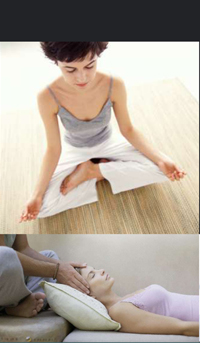Insights
Yoga-based lifestyle reduces inflammation and risk of cardiovascular disease.
by Sanctuary on 07/25/17
I want to highlight how embracing a yoga-based lifestyle, including movement, conscious breathing exercises, and mindfulness, can enhance the reduction in the physical inflammation (triggered by the small, powerful fear center of the brain, the amygdala) and the risk of heart disease.
When many of us hear the word yoga, we think of the many photos we see in magazines of people in twisted, inverted positions posed in breath-taking places, such as the top of a mountain or a rock sticking out of the ocean. Not too realistic for the majority of us, both the poses and the locations! I find myself in awe of such photos, yet being an avid “yogi”, I don’t understand the intention behind such photos. I don’t find them inviting and, instead, find them intimidating and potentially defeating. Yoga is not about competition and getting our bodies into “the perfect pose” to show off to the world. If anything, I think these photos promote competition, which, if we believe we cannot compete due to our body-mind limitations, tends to guide us to not engage at all. And now that more research-based evidence of the health benefits of a yoga-based lifestyle is coming out, we should be doing whatever we can to reflect that yoga is more of an internal journey towards self-acceptance and compassion, not an external experience of comparison.
A yoga-based lifestyle does not mean going to the gym and getting on a mat to exercise and actually does not require a great deal more than what we normally do every day. In fact, you can do yoga without owning a mat or ever leaving your home! What it may mean is that we give ourselves permission to create time for ourselves, reduce our unrealistically long “to do” lists, and prioritize our self-care activities. Simply taking just 30 minutes a day to include some physical and breathing exercises will make a significant change – and it does not have to be 30 minutes in a row. You can even do it while sitting and watching your favorite TV show – using the commercial breaks to simply close your eyes, bring your awareness to your breath, and invite your breath to lengthen and deepen as you take 3-5 inhales and exhales through your nose. Then, if you need a challenge, try focusing on your breath for the whole 2-minute commercial break and notice the body-mind response. You might notice a physical sensation in the body or you might notice an increase in the clarity of your thoughts.
And, as far a yoga positions, when someone asks me for my #1 suggestion, I offer what is referred to as “legs-up-the-wall”, also known in Sanskrit as Viparita Karani. I guide clients to try this pose for the first time with only the heels touching the wall at first (see photo accompanying this post), so there is no tension in the back of the legs. You can do it anywhere, including against the back of a door. Simply lower yourself to the floor near a wall, using a chair if needed to transition to (and back up from) the floor. Find yourself first seated on the floor and then lowering yourself all the way down to one side of your body, curling into a fetal position, with your knees up toward your chest. Now, roll onto your back, extend the legs up into the air and rest the heels on the wall. Once settled into the pose, notice your breath and try smoothing it out as you inhale and exhale through the nose. You can hold this pose as long as it feels comfortable in the body. When ready to release from the pose, reverse the steps you took to get into it. Bend your knees, bring the soles of the feet to the wall and slide them down towards your hips. Roll to one side coming back into a fetal position. Use your top hand to press down into the floor to raise yourself up into a seated position, moving gently and slowly. Take a moment to notice any physical sensations or thoughts in the mind and, when it suits you, transition back to standing, using the chair if needed.
Practicing such a gentle inversion turns on the parasympathetic nervous system, the system of “rest and digest” bringing balance to the sympathetic system that is responsible for activating the “flight and fight” responses instinctual in the human survival optimization system. It is such balancing experiences that support the body’s natural ability to process input, not only the foods we eat, but the sights, sounds, and smells that enter our body through our five senses. When we support our body in this way, we create a healthier environment for the body to maintain its own natural balance, as reflected in measurements of weight, blood pressure, glucose levels, etc., thus reducing the inflammatory response in the body, along with the level of cortisol and the risk of cardiovascular disease.
Making a conscious choice to slow down, embracing the mantra of “less is more”, might be a good place to start when considering a yoga-based lifestyle as a prevention and management intervention for heart disease. And, if you are inspired to “get on the mat” in a yoga class, remember that there is NO perfect pose, only the perfect variation of a pose that moves you both inside and out!
If you are interested in reading more about the research around how a yoga-based lifestyle can reduce the risk of heart disease, click on the link below:
https://www.ncbi.nlm.nih.gov/pmc/articles/PMC4164994/



